Fibers
Definition: a kind of long and thin optical waveguides which can be bent to some degree
Alternative terms: optical fibers, fibres (British spelling)
More specific terms: passive fibers, active fibers, rare-earth-doped fibers, double-clad fibers, step-index fibers, graded-index fibers, polarization-maintaining fibers, silica fibers, fluoride fibers, mid-infrared fibers, single-crystal fibers, plastic optical fibers, dispersion-shifted fibers, photonic crystal fibers, photonic bandgap fibers, hollow-core fibers, nanofibers, single-mode fibers, single-polarization fibers, few-mode fibers, multimode fibers, large-core fibers, large mode area fibers, tapered fibers, telecom fibers, specialty fibers
German: optische Fasern
Category: fiber optics and waveguides
How to cite the article; suggest additional literature
Author: Dr. Rüdiger Paschotta
Optical fibers are the core components of fiber optics and play a particularly important role in photonics in general. They are a kind of optical waveguides, which are usually made of some kind of glass, can potentially be very long (hundreds of kilometers), and are – in contrast to other waveguides – fairly flexible. Although glass is generally quite fragile, particularly thin silica fibers protected with a polymer coating can be bent substantially – for example around your finger – without breaking.
The most commonly used glass for optical fibers is silica (quartz glass, amorphous silicon dioxide = SiO2), either in pure form or with some dopants. Silica is so widely used because of its outstanding properties, in particular its potential for extremely low propagation losses (realized with ultrapure material) and its amazingly high mechanical strength against pulling and even bending (provided that the surfaces are well prepared). However, for some special applications one requires specialty fibers made from other types of glasses, e.g. fluoride fibers (see below).
Most optical fibers used in laser technology have a core with a refractive index which is somewhat higher than that of the surrounding medium (called the cladding). The simplest case is that of a step-index fiber, where the refractive index is constant within the core and within the cladding. The index contrast between core and cladding determines the numerical aperture of the fiber (see below), and is typically small, so that optical fibers are weakly guiding. light launched into the core is guided along the core, i.e., it propagates mainly in the core region, although the intensity distribution may extend somewhat beyond the core. Due to the guidance and the low propagation losses, the optical intensity can be maintained over long lengths of fiber.
Although most optical fibers have only a single core, there are also so-called multi-core fibers containing a few cores or even a large number of those.
A less frequently used principle of guiding light is based on a photonic bandgap (→ photonic bandgap fibers). For example, this can be realized with concentric rings of different refractive index, forming a kind of two-dimensional Bragg mirror.

The term specialty fibers is used for many different kinds of optical fibers with special properties, and is thus not very specific. Such fibers may be based on unusual glasses or just have unusual designs.
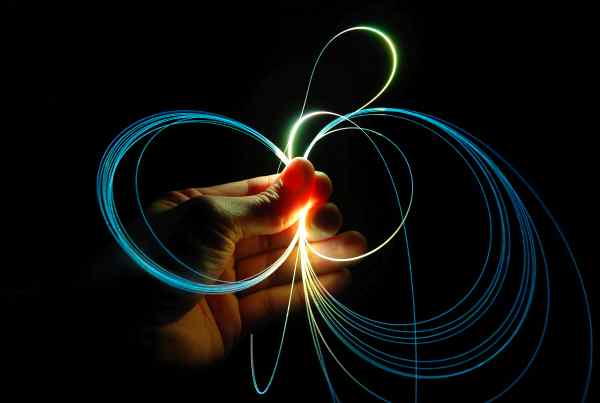
Applications of Optical Fibers
There are many important applications of fiber optics. Some of the most important ones are:
- Optical fiber communications utilize optical fibers mostly for long-range data transmission, but sometimes also for short distances. Huge amounts of data can be quickly sent through a single fiber, which is also immune to external influences such as electric and magnetic fields.
- Active fiber-optic devices contain some rare-earth-doped fiber. Fiber lasers can generate laser light at various wavelengths, and fiber amplifiers can be used e.g. for boosting the optical power or amplifying some weak telecom signals.
- Fiber-optic sensors can be used e.g. for distributed temperature and strain measurements in buildings, oil pipelines, and wings of airplanes.
- Passive optical fibers [14] are useful for transporting light from some source to another point, e.g. for purposes like illumination, diode pumping of lasers and power over fiber. Also, they are used for connecting components in fiber-optic devices, such as interferometers and fiber lasers. They then play a similar role as electrical wires do in electronic devices.
Therefore, fiber optics has become a particularly important area within the technology of photonics.
Fiber Modes – Single-mode versus Multimode Fibers
An optical fiber can support one or several (sometimes even many) guided modes, the intensity distributions of which are located at or immediately around the fiber core, although some of the intensity may propagate within the fiber cladding. In addition, there is a multitude of cladding modes, which are not restricted to the core region. The optical power in cladding modes is usually lost after some moderate distance of propagation, but can in some cases propagate over longer distances. Outside the cladding, there is typically a protective polymer coating, which gives the fiber improved mechanical strength and protection against moisture, and also determines the losses for cladding modes. Such buffer coatings may consist of acrylate, silicone or polyimide, for example. At the fiber ends, the coating often has to be stripped off.
An important distinction is that between single-mode and multimode fibers:
- Single-mode fibers usually have a relatively small core (with a diameter of only a few micrometers) and can guide only a single spatial mode (disregarding the fact that there are two different polarization directions), the profile of which in most cases has roughly a Gaussian shape. Changing the launch conditions only affects the power launched into the guided mode, whereas the spatial distribution of the light exiting the fiber is fixed. Efficiently launching light into a single-mode fiber usually requires a laser source with good beam quality and precise alignment of the focusing optics in order to achieve mode matching. The mode radius of a single-mode fiber is often of the order of 5 μm, but there are also large mode area fibers with single-mode guidance. In the latter case, the alignment tolerances are lower in terms of position but higher in terms of angle (which may be less problematic).
- Multimode fibers have a larger core and/or a larger index difference between core and cladding, so that they support multiple modes with different intensity distributions (Figure 3). In this case, the spatial profile of light exiting the fiber core depends on the launch conditions, which determine the distribution of power among the spatial modes.
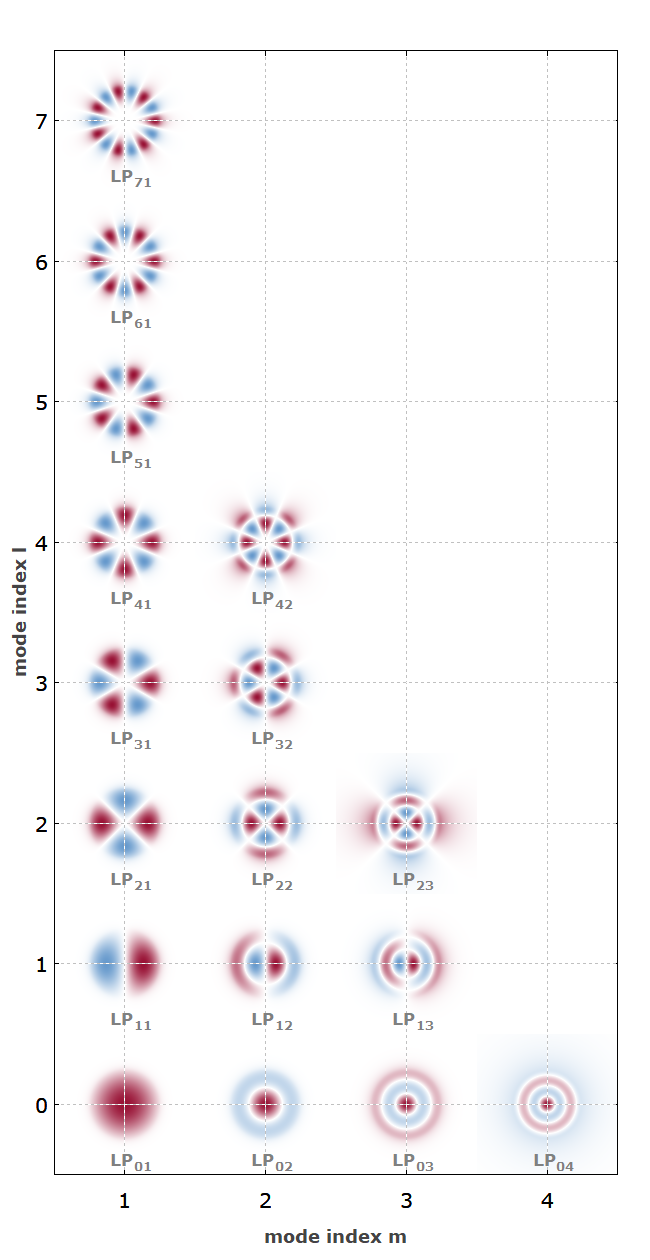
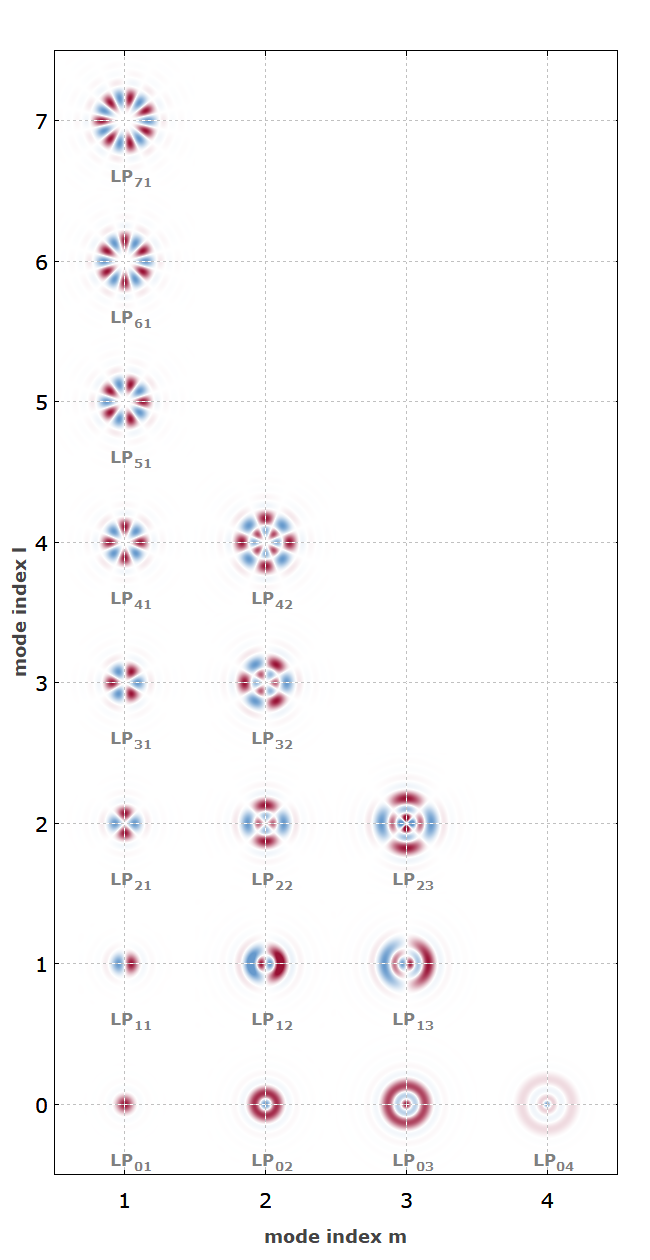
Long-range optical fiber communication systems usually use single-mode fibers, because the different group velocities of different modes would distort the signal at high data rates (→ intermodal dispersion). For shorter distances, however, multimode fibers are more convenient as the demands on light sources and component alignment are lower. Therefore, local area networks (LANs), except those for highest bandwidth, normally use multimode fiber.
Single-mode fibers are also normally used for fiber lasers and amplifiers. Multimode fibers are often used, e.g., for the transport of light from a laser source to the place where it is needed, particularly when the light source has a poor beam quality and/or the high optical power requires a large mode area.
Different modes of an optical fiber can be coupled via various effects, e.g. by bending or often by irregularities in the refractive index profile. These may be unwanted or purposely introduced, e.g. as fiber Bragg gratings. Waveguide theory shows that an important factor for the coupling between different fiber modes is the difference in their wavenumbers, which for efficient coupling has to match the spatial frequency of a coupling disturbance.
Main Parameters
The design of a step-index fiber can be characterized with only two parameters, e.g. the core radius a and the refractive index difference Δn between core and cladding. Typical values of the core radius are a few microns for single-mode fibers and tens of microns or more for multimode fibers.
Instead of the refractive index difference, one usually uses the numerical aperture, defined as
which is the sine of the maximum acceptable angle of an incident beam with respect to the fiber axis (considering the launch from air into the core in a ray-optic picture). (n0 is the refractive index of the surrounding medium – close to 1 in case of air.) The NA also quantifies the strength of guidance. Typical values are of the order of 0.1 for single-mode fibers, even though actual values vary in a relatively large range. For example, large mode area single-mode fibers can have low numerical apertures below 0.05, whereas some rare-earth-doped fibers have values of 0.3 and higher for a high gain efficiency. NA values around 0.3 are typical for multimode fibers. The sensitivity of a fiber to bend losses strongly diminishes with increasing NA, which causes strong confinement of the mode field to the core.
Another frequently used parameter is the V number
which is a kind of normalized frequency. Single-mode guidance is achieved when the V number is below ≈ 2.405. Multimode fibers can have huge V values. The number of modes then scales with V2.
As a numerical example, consider a typical step-index silica fiber for single-mode operation in the 1.5-μm spectral region, with a cut-off wavelength of 1.3 μm and a numerical aperture of 0.1. The refractive index of the pure silica cladding at 1.5 μm is ≈ 1.444. The core index is ≈ 1.4475, i.e., the index difference is ≈ 0.0035. The core diameter is 10 μm, and the V number is 2.1.
Refractive Index Profiles
The refractive index profile of optical fibers often deviates substantially from that of a step-index profile (with constant refractive index within the core):
- Due to preferential evaporation of the dopant during the collapse of the preform (assuming that the preform is made with chemical vapor deposition, see below), there is often a pronounced index dip at the center. For single-mode fibers with small mode areas, this does not need to have a strong impact on the mode field distribution, which in most cases closely resembles a Gaussian shape.
- Some fibers are made with graded index profiles (graded-index fibers) where the refractive index is gradually reduced away from the center, e.g. with a parabolic shape. Parabolic index profiles are useful e.g. for multimode fibers because they minimize intermodal dispersion (see below).
- There are also “W profiles”, where the core is surrounded by a region with a refractive index lower than that of the cladding (depressed cladding). In principle, there can even be additional index steps, or combinations with smooth refractive index variations.
- Triangular, trapezoidal and Gaussian index profiles are used for dispersion-shifted fibers.
- Index profiles do not need to be cylindrical. For example, an elliptical core shape can provide increased birefringence (→ polarization-maintaining fibers) or even single-polarization guidance (→ single-polarization fibers) (see below).
Note that the definitions of the numerical aperture and consequently of the V number become somewhat ambiguous for non-rectangular index profiles.
In addition, there are so-called photonic crystal fibers (see below), where the refractive index profile is strongly structured.
Propagation Losses
The power losses for light propagating in an optical fiber can be extremely small, particularly for single-mode silica fibers as used in telecommunications. The resulting attenuation is typically dominated by Rayleigh scattering for short wavelengths and by multiphonon absorption at long wavelengths. Rayleigh scattering results from refractive index fluctuations, which are to some extent unavoidable in a glass, but can be strongly increased by concentration fluctuations in fibers with high numerical aperture. Other loss contributions come from inelastic scattering (spontaneous Brillouin scattering and Raman scattering), from absorbing impurities, and from fluctuations of the core diameter.
For silica fibers, the loss minimum occurs around 1.5–1.6 μm and can be below 0.2 dB/km (≈ 4.5% per km), which is close to the theoretical limit based on Rayleigh scattering in an amorphous glass material. There is often some loss peak around 1.4 μm, which can be largely eliminated, however, by carefully optimizing the chemical composition of the core so as to reduce the OH content (i.e. the concentration of hydroxyl bonds). Interestingly, fibers with high OH content can exhibit lower losses for ultraviolet light, whereas they exhibit pronounced loss peaks in the infrared spectral region.
Multimode fibers, and in general fibers with high numerical aperture, tend to have significantly higher propagation losses, essentially because the higher doping level of the core increases the scattering losses. Rare-earth-doped fibers also have much higher losses, but as more than some tens of meters of such a fiber are rarely used, this usually does not matter for their applications.
Polarization Properties
Despite the typically cylindrical symmetry, fibers usually exhibit some amount of birefringence which can cause the polarization state of light to evolve in an uncontrolled way (→ polarization of light). There are special polarization-maintaining fibers with a strong built-in birefringence to solve this problem. In addition, there are single-polarization fibers, which guide only light with one polarization direction. There are also various types of fiber polarization controllers, which allow one to adjust the state of polarization in a fiber.
Dispersion Properties
As a result of the waveguide properties, the chromatic dispersion of an optical fiber can deviate significantly from its material dispersion, particularly when the mode area is small (→ waveguide dispersion). This makes it possible to obtain unusual dispersion properties by engineering the waveguide properties. For example, dispersion-shifted fibers can have near zero dispersion in the 1.5-μm spectral region, and there are dispersion-flattened fibers with small dispersion over a large wavelength range or dispersion-decreasing fibers. A particularly high design freedom exists for photonic crystal fibers (see below).
The birefringence makes the group delay polarization-dependent; this is often called polarization mode dispersion. For multimode fibers, there is also intermodal dispersion, i.e., a dependence of the group velocity on the fiber mode, which may be minimized by choosing a suitable refractive index profile but is typically larger than the dispersion of single-mode fibers.
Fiber Fabrication
Most optical fibers are fabricated by pulling from a so-called preform, which is a glass rod with a diameter of a few centimeters and roughly 1 m length. Along its axis, the preform contains a region with increased refractive index, which will form the core. When the preform is heated close to the melting point in a furnace (oven), a thin fiber with a diameter of typically 125 μm and a length of many kilometers can be pulled from the bottom of the preform. Before the fiber is wound up, it usually obtains a polymer buffer coating for mechanical and chemical protection.
The core of a fiber can be doped with laser-active ions, normally rare earth ions of erbium, neodymium, ytterbium, or thulium. When these ions are excited with suitable pump light, optical amplification occurs, which can be used in fiber lasers or amplifiers.
More details are given in the article on fiber fabrication.
Fiber-optic Cables
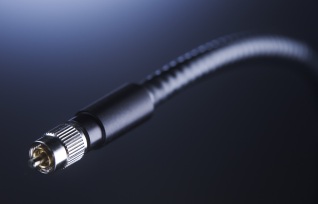
Glass fibers are amazingly robust, considering that glass is known as a particularly fragile material. However, additional protection is often required when fibers are used in an environment which is e.g. accessible by operators. For laboratory use, e.g. for sending light from a telecom setup to some diagnostic instrument and also in large industrial assemblies, it is convenient to use connectorized fiber cables (fiber patchcords, see Figure 5), where the actual fiber is surrounded by additional protective layers. While the bare glass fiber may have a typical diameter of 125 μm, and the polymer buffer and jacket increase this to a few hundred micrometers, the total diameter of the fiber cable may be several millimeters. Apart from considerably strengthening the cable, the (typically yellow) cable material also makes it much easier for operators to recognize the fiber, thus avoiding too harsh treatment in the first place.
Thicker fiber cables are used for the delivery of high-power beams, e.g. from fiber-coupled diode lasers to a solid-state laser head or to some material processing equipment. For power levels of hundreds of watts to many kilowatts, the fiber cable may have a diameter of several centimeters. High-power fiber cables may also contain sensors for detecting damage to the cable, so that the laser source can be immediately switched off when there is a risk that high-power laser radiation exits the cable at a damaged point. Such precautions can be very important for laser safety.
Fiber cables for long-haul optical fiber communications are also fairly thick, because they often have to pass through harsh environments and must be protected accordingly. In extreme cases, such cables may be lying on the sea bed or are slightly buried there. A high level of protection is required against the mechanical stress both during installation and at later times.
Of course, a fiber cable can contain multiple fibers. In this way, the already huge data transmission capability of a single fiber can be multiplied to enormously high levels.
Fiber-optic Components
Many optical components can be directly made from fibers. Some examples are:
- Fiber couplers allow to couple light typically between two fibers, typically with the coupling coefficient depending on the optical wavelength.
- Fiber Bragg gratings provide strongly wavelength-dependent reflection and transmission properties. They can be used e.g. as optical filters or for introducing chromatic dispersion into a system.
- Fiber polarizers can be made e.g. with special single polarization fibers which can guide only light with a certain polarization direction.
- Fiber amplifiers can amplify light in certain wavelength regions.
Other fiber-optic components contain bulk elements with attached fiber connections. Examples of so-called fiber-pigtailed devices are:
- Semiconductor optical amplifiers can provide amplification in a semiconductor waveguide.
- Fiber-coupled diode lasers send light into a single-mode or multimode fiber.
- Various types of optical modulators such as electroabsorption modulators and electro-optic modulators are usually based on other types of waveguides which can be coupled to fibers.
- Faraday isolators, Faraday mirrors and circulators contain bulk-optical rotator elements and collimation optics.
- Fiber-optic switches as used e.g. for fiber-optic networks can be realized with various technologies, e.g. with electro-optic modulators or with micro-electromechanical systems (MEMS).
Fiber collimators provide a connection between fiber optics and free-space optics. Essentially, such a device contains a collimation lens, transforming the strongly divergent beam from a fiber end into a collimated beam. Finally, there are mechanical splices, providing semi-permanent connections between fibers.
Polishing, Cleaving, and Splicing
Clean and smoothly shaped fiber ends can be produced with polishing techniques. These can also be used to produce end faces which are not perpendicular to the fiber axis. With a tilt angle of the order of 10° (angle polishing), reflections from fiber ends can be effectively eliminated from the beam path, so that e.g. reflection-sensitive lasers are well protected.
A much faster technique for preparing fiber ends is cleaving. Here, one typically pulls the fiber while scratching it from a side, e.g. with a vibrating diamond blade. This makes the fiber break with normally fairly smooth end faces – at least around the core region. By twisting the fiber during this process, angle cleaves can be fabricated, but the results are less reproducible than for polishing techniques.
Optical fibers (particularly those made of silica) can also be spliced together. One may use the technique of fusion splicing for making permanent fiber joints. A simpler technique is mechanical splicing, where the fiber ends are firmly held together by some mechanical means, but not fused. Here, however, the splice losses are typically higher, even when reduced with an index-matching gel between the surfaces.
There are also many types of fiber connectors which allow one to obtain good mechanical contact (as in a mechanical splice), but also to disconnect the fibers easily as required.
In general, the handling of fiber ends is fairly delicate, compared with the handling of electrical connections. Apart from problems with dust, grease and the like, fiber ends are relatively sensitive and are easily scratched. Their handling often requires very expensive equipment (e.g. high-quality fusion splicers), particularly when reliable results are required under field conditions, i.e., in a comparatively dirty environment. On the other hand, a fair comparison with electrical cables has to take into account the much higher transmission capacity of a fiber.
Safety Issues
Laser safety in terms of eye safety is a serious issue with high-power fiber devices. Very harmful high-power light could exit a damage fiber cable; therefore, such cables must be well protected against damage and possibly monitored with built-in sensor systems.
In optical fiber communications, the optical power levels are often small enough to avoid eye safety problems, particularly when using the eye-safe wavelength region around 1.5 μm. However, dangerous power levels can sometimes occur, e.g. in cable TV applications, where a high-power amplifier creates sufficiently signal power for splitting signals into many fibers.
Another risk for eyes is not associated with laser radiation, but with the sharp scraps of fiber ends, as are obtained e.g. when cleaving fibers. These scraps are extremely sharp, may be transported into eyes e.g. when they stick to a finger, and may also penetrate the skin. They should also not be ingested. For such reasons, one should carefully dispose fiber scraps into a properly marked container immediately when they occur, take precautions to make them well visible in the working area, and avoid any eating or drinking near the work area.
Special Types of Fibers
So-called double-clad fibers can have a single-mode core and a multimode inner cladding, the latter transporting the pump light e.g. of a high-power fiber laser or amplifier.
There are various kinds of polarization-maintaining fibers, mostly realized on the basis of strong birefringence. The linear polarization of light is preserved provided that the initial polarization axis is aligned with a birefringent axis of the fiber. In addition, there are also single-polarization fibers (polarizing fibers) where one polarization direction experiences strong losses.
A special kind of optical fibers is the photonic crystal fiber (PCF), also called microstructure fiber or holey fiber. Such fibers typically consist only of a single material (usually silica), containing very small air holes with diameters well below 1 μm. Fabrication of such fibers is possible by using preforms with holes, made e.g. by stacking capillary tubes. By varying the arrangement of air holes, fibers with extremely different properties can be made, e.g.
- extremely large or small mode areas, leading to extremely weak or strong nonlinearity
- single-mode guidance in very large wavelength regions (endlessly single-mode fibers)
- guidance with the light field dominantly propagating in an air hole (air-guiding photonic bandgap fibers)
- unusual chromatic dispersion properties, e.g. anomalous dispersion in the visible spectral region
Photonic crystal fibers are now attracting strong interest for a wide range of applications, including extremely nonlinear fiber devices, soliton fiber lasers operating at short wavelengths, and high-power fiber amplifiers.
Although most fiber cores consist of some variant of silica (e.g. germanosilicate or aluminosilicate glass), other glass materials can also be used. Examples are
- phosphate glasses mainly for fiber amplifiers and lasers (low quenching tendency even for high rare earth doping concentrations)
- chalcogenide glasses (sulphide, telluride, or selenide glasses), having small phonon energies, mainly used for mid-infrared applications
- fluoride glasses, also with small phonon energies, used in fluoride fibers for mid-infrared and upconversion lasers
Low-cost multimode fibers can be made of polymers (plastic optical fibers, POF), which are cheap materials, allow simple production by extrusion, and are robust and flexible even when made with larger diameters. In some application areas, they allow for substantially cheaper solutions than possible with glass fibers. Even photonic crystal fibers can nowadays be produced from polymers. Some polymer fibers can also be used to guide terahertz waves.
In some cases, fibers are made of crystalline materials such as sapphire, but these fibers are usually not flexible and can be seen as thin rods using waveguide propagation (with or without a core structure at the center). They can be used for very high-power fiber lasers and amplifiers.
Damage of Fibers
Optical fiber devices can be damaged in various ways during operation. Various aspects are relevant in this context:
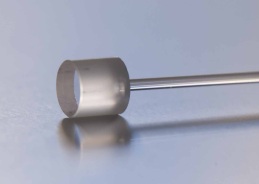
- The fiber ends are particularly vulnerable to laser-induced damage. The air–glass interface has a lower damage threshold than the bulk material. For example, for silica fibers the surface damage fluence is ≈ 22 J/cm2 for 1-ns pulses at a wavelength of 1 μm [11]. For pulses with higher peak intensity or fluence, it may then be necessary to use core-less end caps (Figure 6). Fiber surfaces become even more vulnerable if there is any dust. Also, launching a high optical power into a fiber end can overheat the nearby polymer coating.
- For not even very high average powers, initial damage of a fiber end can have the consequence of a fiber fuse propagating through the whole fiber in the backward direction.
- For too high peak powers, self-focusing can occur, which further increases the intensity and leads to immediate damage. For silica fibers, this effect tends to occur above a threshold power of roughly 4 MW, relatively independent of the mode area.
- In high-gain fiber amplifiers made with rare-earth-doped fibers, parasitic lasing can occur, followed by a kind of Q-switching effect which can destroy the fiber.
- For a too high dissipated power per unit length, a fiber can become overheated. This applies particularly to acrylate coatings. Water cooling provides an efficient means to suppress such effects.
Comparison of Optical Fibers with Electric Cables
In some technical areas, such as optical data transmission over long distances or between computer chips, optical fibers (or other waveguides) compete with electric cables. Compared with the latter, they have a number of pronounced advantages:
- Fiber cables are much less heavy than electric cables.
- The capacity of a fiber for optical data transmission is orders of magnitude higher than for any electric cable.
- The transmission losses of a fiber can be very low: well below 1 dB/km for the optimum wavelengths, which are around 1.5 μm.
- A large number of channels can be reamplified in a single fiber amplifier, if required for very large transmission distances.
- Optical data connections via fibers are comparatively hard to intercept and manipulate, which gives additional security even without using encryption techniques. For very high security, quantum cryptography can be used.
- Fiber connections are immune to electromagnetic interference, problems with ground loops, and the like.
- Fibers do not introduce fire hazards or the risk of triggering explosive substances (unless a fiber carrying a high optical power breaks).
On the other hand, fibers also have their disadvantages:
- Fiber connections are comparatively sensitive and difficult to handle, particularly when single-mode fibers are used. Precise alignment and high cleanliness are required. For such reasons, fiber connections are often only competitive if a high transmission bandwidth can be utilized.
- Glass fibers may not be bent very tightly, because this can cause high bend losses or even breakage. This can be a problem e.g. in the context of fiber-to-the-home technologies. Note, however, that silica fibers are surprisingly robust against bending – much more than most other things made of glass.
Suppliers
The RP Photonics Buyer's Guide contains 157 suppliers for fibers. Among them:

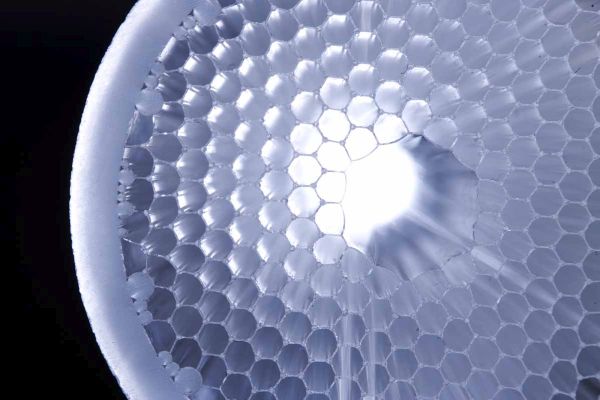
NKT Photonics
Our Crystal Fibre portfolio of specialty fibers spans from nonlinear fibers optimized for octave spanning supercontinuum generation, over the World’s largest single mode ytterbium gain fibers for high power lasers and amplifiers, to advanced hollow core fibers guiding the light in air. Our single-mode LMA fibers are also available as patch cords with standard termination in our aeroGUIDE product range.


TOPTICA Photonics
Optical fibers from TOPTICA: ideally suited for TOPTICA's tunable diode lasers:
- polarization maintaining (PM)
- high power, AR, and fiber splitters/combiners
- wide wavelength coverage (350 nm – 1625 nm)
- ideal match for FiberDock & FiberOut
- individual fiber options for various applications
Questions and Comments from Users
Here you can submit questions and comments. As far as they get accepted by the author, they will appear above this paragraph together with the author’s answer. The author will decide on acceptance based on certain criteria. Essentially, the issue must be of sufficiently broad interest.
Please do not enter personal data here; we would otherwise delete it soon. (See also our privacy declaration.) If you wish to receive personal feedback or consultancy from the author, please contact him e.g. via e-mail.
By submitting the information, you give your consent to the potential publication of your inputs on our website according to our rules. (If you later retract your consent, we will delete those inputs.) As your inputs are first reviewed by the author, they may be published with some delay.
Bibliography
| [1] | K. C. Kao and G. A. Hockham, “Dielectric-fiber surface waveguides for optical frequencies”, Proc. Inst. Elect. Eng. 113, 1151 (1966), doi:10.1049/piee.1966.0189 |
| [2] | K. C. Kao and T. W. Davies, “Spectrophotometric studies of ultra low loss optical glasses – I: Single beam method”, J. Phys. E 2 (1), 1063 (1968), doi:10.1088/0022-3735/1/11/303 |
| [3] | D. Gloge, “Weakly guiding fibers”, Appl. Opt. 10 (10), 2252 (1971), doi:10.1364/AO.10.002252 |
| [4] | W. A. Gambling, “The rise and rise of optical fibers”, JSTQE 6 (6), 1084 (2000) (an informative review on the development of glass fibers) |
| [5] | A. W. Snyder, “Guiding light into the millennium”, J. Sel. Top. Quantum Electron. 6 (6), 1408 (2000), doi:10.1109/2944.902195 |
| [6] | M. J. Padgett, “Orbital angular momentum 25 years on”, Opt. Express 25 (10), 11265 (2017), doi:10.1364/OE.25.011265 |
| [7] | Timbercon's fiber-optic keywords |
| [8] | A. W. Snyder and J. D. Love, Optical Waveguide Theory, Chapman and Hall, London (1983) |
| [9] | J. Hecht, City of Light, The Story of Fiber Optics, Oxford University Press, New York (1999) |
| [10] | J. A. Buck, Fundamentals of Optical Fibers, Wiley, Hoboken, New Jersey (2004) |
| [11] | W. Koechner, Solid-State Laser Engineering, 6th edn., Springer, Berlin (2006) |
| [12] | F. Mitschke, Fiber Optics: Physics and Technology, Springer, Berlin (2010) |
| [13] | R. Paschotta, Field Guide to Optical Fiber Technology, SPIE Press, Bellingham, WA (2010) |
| [14] | R. Paschotta, tutorial on "Passive Fiber Optics" |
| [15] | R. Paschotta, tutorial on "Modeling of Fiber Amplifiers and Lasers" |
See also: fiber optics, silica fibers, plastic optical fibers, rare-earth-doped fibers, mid-infrared fibers, double-clad fibers, single-mode fibers, multimode fibers, graded-index fibers, modes, LP modes, photonic crystal fibers, large mode area fibers, specialty fibers, effective mode area, mode field converters, cut-off wavelength, tapered fibers, polarization-maintaining fibers, dispersion-decreasing fibers, dispersion-shifted fibers, fiber Bragg gratings, fiber-optic sensors, power over fiber, fiber lasers, waveguides, cladding modes, polarization mode dispersion, numerical aperture, fiber joints, cleaving of fibers, fusion splicing of fibers, core-less end caps, fiber fuse, The Photonics Spotlight 2006-12-03
and other articles in the category fiber optics and waveguides

This encyclopedia is authored by Dr. Rüdiger Paschotta, the founder and executive of RP Photonics Consulting GmbH. How about a tailored training course from this distinguished expert at your location? Contact RP Photonics to find out how his technical consulting services (e.g. product designs, problem solving, independent evaluations, training) and software could become very valuable for your business!
 |









If you like this page, please share the link with your friends and colleagues, e.g. via social media:
These sharing buttons are implemented in a privacy-friendly way!